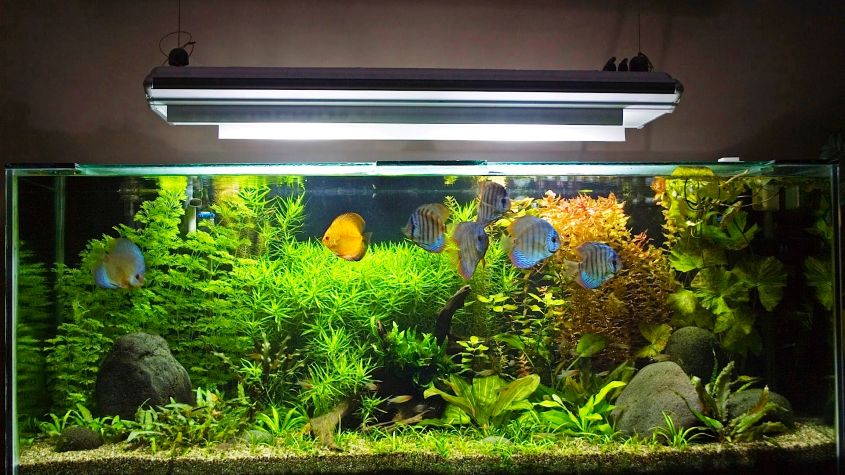Getting an aquarium can be the initial step towards pet keeping, especially if you’ve never had a pet in your life. However, buying an aquarium (and associated accessories) is one thing, and petting your fish in a habitable environment is altogether a different scenario. That’s because fish are very sensitive towards temperature levels, pH levels and other variables which need to be kept in mind to provide them a suitable environment.
For most people, keeping fish in the aquarium can be a stressful experience as fish aren’t able to acclimatize. It leads to high mortality rate due to infections, nitrate and ammonia levels or lack of favorable bacteria in the water. As mentioned before, fish are very sensitive to factors like environmental changes, therefore fluctuating temperature levels, frequent water changes and depleting oxygen levels in the tank can also lead to fatalities.
So, consider all that goes into good fish care before buying an aquarium. Read as much as you can about the measures you need to take to maintain an aquarium. This will help sustain a healthy ecosystem for fish and make your task less stressful.
Also Read: 20 Best Aquarium Setup Ideas for Fish Lovers
Here are some useful tips to employ to ensure a healthy environment for your fish.
1) Cycle the water
Once you’ve got the aquarium, fill it with water and cycle it for 24 hours in repeated intervals of filtration. Never put the fish directly into fresh water as they will get shocked by their new ecosystem. Moreover, cycling water will breed good bacteria in the aquarium water.
2) Filtration
Make it a habit to filter the water for at least two hours daily to simulate the effect of running water inside the tank. This will clean the aquarium water as the toxins and dirt gets absorbed in the filter sponge. Some filters have air intake as well which will promote the oxygen levels inside the tank.
3) Water conditioner
Water used in aquarium needs to be free from chlorine content and abundant in nitrifying bacteria to keep the nitrate and ammonia levels down. Whenever you add fresh water to the tank, add a few drops of anti-chlorine and nitrifying bacteria in it. These two are easily available at a pet shop in one or two separate solutions.
4) Change the water
Once you get the hang of it, you should change 10-15% of aquarium water with fresh water once every two weeks. Other than that, change 25% of your aquarium water once a month. To do this, siphon the water with a gravel vacuum to remove physical debris.
Before changing the water, check the parameters of the tank and freshwater that will be the replacement. The pH level should be in the range of 6.5 – 7.5, which is suitable for most fish species.
Also, check the degree of carbonate hardness (denoted by dKH) which indicates the pH stability level. Anything over 4.5 dKH or 80 ppm (parts per million) is good. If it goes below that level, you can use a half teaspoon of baking soda to raise carbonate hardness by 1 dKH (17.8 ppm).
Another factor that is determinant of fish health in the tank is the level of nitrate and ammonia. Under normal circumstances, nitrates should be negligible or below 10 ppm in freshwater.
5) Water temperature
This is one factor that determines the health of fish inside the aquarium. Changing the temperature too often stresses them out and makes them susceptible to infections. Tropical freshwater fish thrive in temperature ranging from 72°F – 82°F, and in most cases, a heater is required to maintain a constant temperature.
6) Don’t overcrowd
You’ve got a new aquarium, and you want to keep plentitude of fish in it. This is the most common mistake every newbie makes. They put too many fish inside a small tank, which ultimately stresses them out and depletes oxygen levels in the tank. This can clog the filter, deplete the quality of water and ultimately cause fatalities.
Always make it a point to consult a specialist (in most cases the person you bought the fish tank from) as to how many and what species of fish to go for initially. For example, goldfish should be kept with a shark or angelfish. On the other hand, keeping them with fish species like Texas cichlid is not a good idea as they are known for bullying goldfish.
7) Feeding fish
As a newbie, you might be tempted to overfeed them, but never do it. Give your fish frequent, small meals that mimic how they feed in nature. Consult your local pet seller to know what kind of feed is appropriate for the fish in your tank. These meals come in a preprocessed form in a digestible size for the fish.
Also, occasionally treat your fish with vegetables and fruits like broccoli, cucumber, cauliflower, carrots, and apples. Chop fruits/veggies in small pieces and boil for a while. Drain the soup and feed you fish with boiled green delight once it comes to normal temperature. This provides them with the nutrients missing in supplemental meals and keeps their color vibrant and guts in prime health.
8) Detect signs of illness
It is very important to keep an eye on the health of your fish on a daily basis. The way they eat and move in the tank indicates their health. If your fish is lethargic, not eating enough, or gasping for air, it means something is wrong. Check for the development of flakes on their skin or any abnormal inflammation in the stomach.
If your fish shows such symptoms, immediately put some anti-infecting drops in the water. Alternatively, fill a tub with water and add some salt, then take out the fish and put it inside it for a few minutes. You can also add some anti-infecting drops in the water and let her get better for some time.
9) Bullying
It is natural for the fish inside the tank to mark its area (territorial behavior) and fight for its place. In some cases, one species can bully others by biting her fins and tail. Look out for these signs and keep the bullying fish in a separate vessel (inside the tank) for a while. If you don’t see any change, repeat the process.
As an alternative, you can create a physical barrier between the fish being bullied by inserting a piece of glass inside the aquarium. The glass needs to be precisely equal to the width and height of the tank.
This also comes handy when fish have mated and newly born fish need protection from bigger fish that can gobble them up at the very first chance.
Another method is to isolate the bully for a few days inside a smaller container with proper air inlets. This will get the bully confused about its territory and let the fish that was being distressed ease inside the environment. Once things have calmed down, release the fish and check its behavior. If the need arises, isolate her again.
10) Cleaning the tank
Apart from cleaning the water, you need to clean the walls of the aquarium glass as algae build up on it. They rob the aquatic plants of much-needed nutrition and also pose health concerns for fish. There are different tools that can be used to clean the tank-like scrub brushes and algae magnet to remove it without having to put your hands inside the tank. Or you can take a piece of sponge used to clean the aquarium glass to clean it.
Follow Homecrux on Google News!




